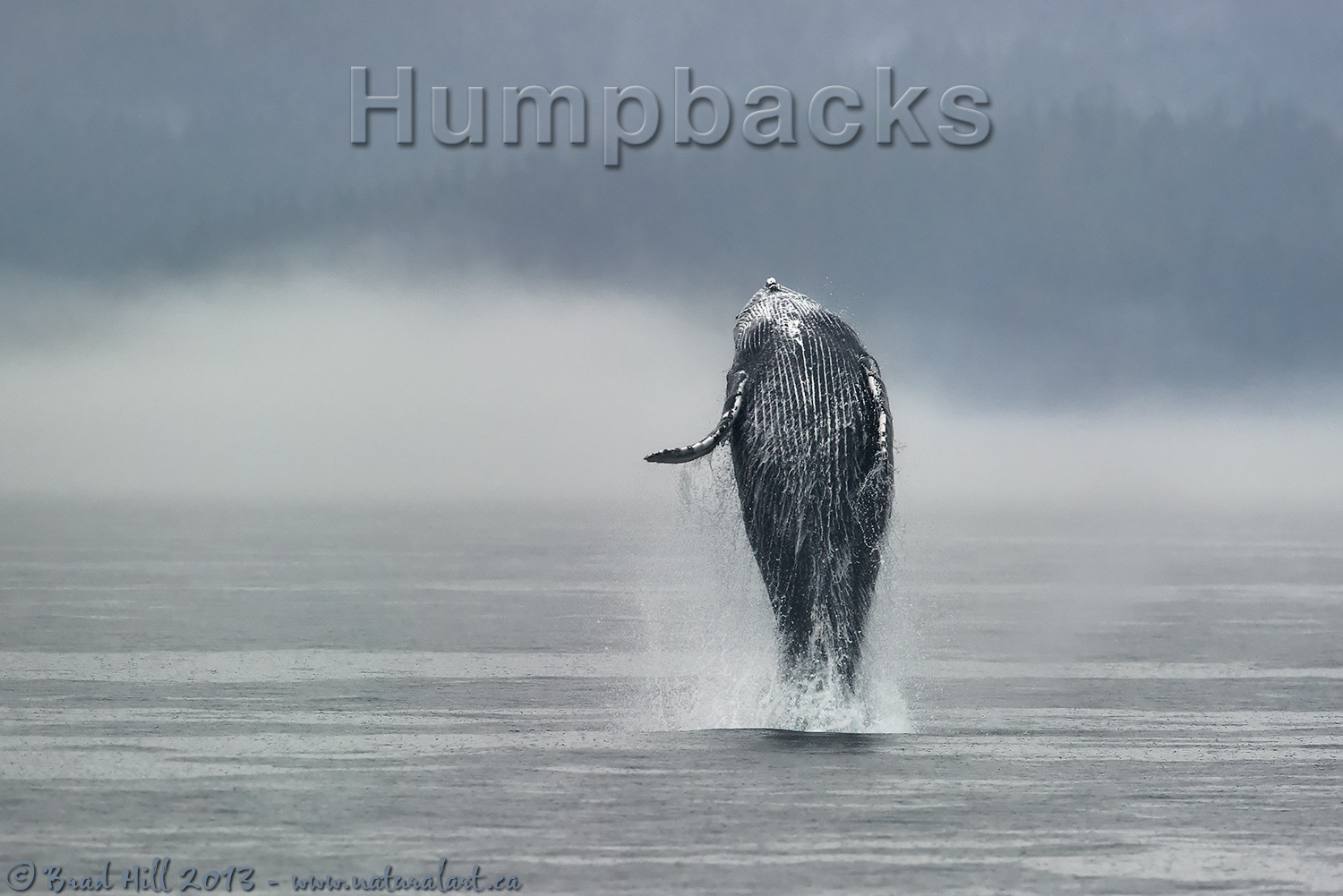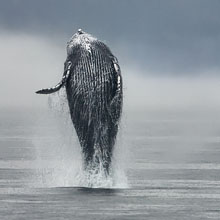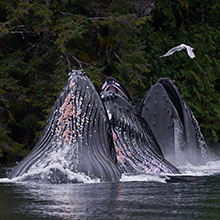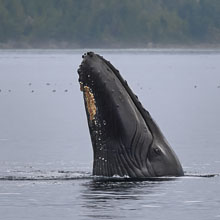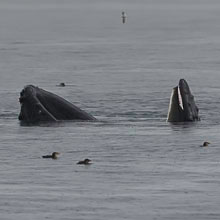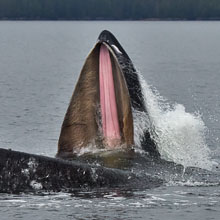Availability: Undetermined - Enquiries?
In the Field
Celebrating the Wild Life. Johnston's Strait region of northern Vancouver Island, BC, Canada. August 21, 2011.
This is the first shot of a 7-image sequence that took place in just a little under one second in August of 2011. The remaining 6 shots can be viewed beginning here.
Some things seen in nature almost don't add up. Seeing a massive creature like a humpback whale exit the ocean in a short flight that literally defines the phrase "grace in motion" is DEFINITELY one of those things! How the heck can a 35 ton "blob" acquire the coordination and agility of a ballerina?? Simply mind-boggling!
And...why on earth DO whales breach in the first place? Some argue that breaching - and the resounding and almost deafening "crack" they produce when they land - serves a communication function. The "target" of the communication may be other whales (in this case other humpbacks) or, some have suggested, it may even be directed at boats (as a warning for them to stay back). Others have observed that following a breach a lot of "debris" (including dead skin and parasites like sea lice and barnacles) are found in the ocean and have argued that breaching serves to scour the skin. But ultimately no one is sure of the exact reason behind breaching. So no one can really argue against the idea that this whale wasn't just doing it to celebrate the wild life it leads! While I watched this whale it was REALLY hard to stifle the thought that this whale was breaching simply for the sheer joy of it.
I shot this image on a rainy, foggy August afternoon from the deck of a sailboat. In many ways this was - at least technically - one of the most challenging shots I've ever had to capture. Humpbacks breach quite unpredictably - and figuring out where they're going to surface is pure guess-work. We chose to sit a long ways back from this whale (which was repeatedly breaching) to avoid disturbing it. This meant that the only way to capture it was to use a long telephoto (I used a 600mm lens for this shot). Which produced challenge #1 - getting the whale within the narrow field of view (and thus the viewfinder and image frame) in the split second when the whale surfaced. And, the "how to get it in the viewfinder issue" was compounded more by the fact that we had been in the rain so long that my eyepiece was completely fogged up (even though I use anti-fog eyepieces). The solution to the problem? I had my 600mm lens mounted on a firm tripod and Wimberley head - so the lens moved easily and smoothly. I placed my left arm along the entire length of the top surface of the lens so it was fully outstretched (and with fingers extended to the end of the lens). That left me with a long pointing arm. And, you guessed it, I used that arm as a "sight" - rather than looking through my viewfinder I simply swung my arm at the target (and, of course, the lens followed) and began firing. With a little practice and "calibration" I quickly was able to judge exactly when subjects would be in my viewfinder without looking through it. Problem #1 solved!
And then there was problem #2 - focusing. Before the whale surfaced this was a scene that had virtually ZERO contrast in it. Basically, there was NOTHING to focus on in the distance range of the whale! Expecting my AF system to focus on an off-centre whale in the instant it breached was asking too much. Before the whale surfaced, the AF on any lens I tried (from wide angle through to my 600) simply racked in and out and found nothing to "grab" on to. So, I manually focused on the faint ripples on the surface at a distance where I HOPED the whale would surface. Then, each time it breached, I swung my arm around and fired. Amazingly, I ended up with a high hit rate for focus, but that hit rate was high only when the whale was in the centre of the frame. This shot is one of the only frames with an off-centre whale that came out sharp (this is close to the full frame shot and I didn't move the whale off-centre via cropping). Lady luck was smiling on me when I captured this!
But back to the whales themselves: The story of the humpback whale on the central and northern coast of BC is one of past sorrow, current joy, and fear for the future. The past sorrow side comes from how unrestricted whaling absolutely decimated their populations in the recent past. Fortunately, despite mankind's best efforts to eradicate humpbacks and the other giants of the oceans, we can now feel joy at how the humpback populations are finally rebounding. Humpback sightings are dramatically more common today on the BC coast than even one short decade ago!
But after a recovery that took many decades to accomplish, the whales - and the entire marine ecosystem along a huge stretch of the BC coast - face a new and ominous threat. Recently a new pipeline has been proposed to carry oil from Alberta's tar sands over to Kitimat on the BC coast. The oil then would be loaded on to massive super-tankers that would navigate through the treacherous and stormy waters of the Great Bear Rainforest - waters that have claimed countless vessels, including the Queen of the North ferry just a few years back. The thought of the consequences of a possible - and even likely - oil spill in this region is chilling, to say the least.
Here's a higher resolution (2400 pixel) version of this spectacular breach:
• Celebrating the Wild Life - 1 of 7: Download 2400 pixel image (JPEG: 1.2 MB)
ADDITIONAL NOTES:
1. This image - in all resolutions - is protected by copyright. I'm fine with personal uses of it (including use as desktop backgrounds or screensavers on your own computer), but unauthorized commercial use of the image is prohibited by law. Thanks in advance for respecting my copyright!
2. Like all wildlife photographs on this website, this image was captured following the strict ethical guidelines described in The Wildlife FIRST! Principles of Photographer Conduct. I encourage all wildlife photographers to always put the welfare of their subjects above the value of their photographs.
3. This image was captured during my "Humpback, Orcas, Sea Lions & More" photo tour in August of 2011. Each year I offer trips into two different parts of the Great Bear Rainforest as well as one to photograph aquatic mammals and oceanscapes near the northern tip of Vancouver Island. And, in selected years, I also offer photo tours to locations to capture other highly sought-after subjects, such as various owl species of the boreal forest and wildlife of Canada's Arctic. Details about these trips can be found on the Photo Tours page of this website.
Behind the Camera
Celebrating the Wild Life. Johnston's Strait region of northern Vancouver Island, BC, Canada. August 21, 2011.
Digital Capture; Compressed RAW (NEF) 14-bit format; ISO 1600
Nikon D3s with Nikkor 600mm f4 VRII lens supported on carbon fibre Gitzo 1348 tripod with Wimberley head.
1/2000s @ f5; +0.67 stop compensation from matrix-metered exposure setting.
At the Computer
Celebrating the Wild Life. Johnston's Strait region of northern Vancouver Island, BC, Canada. August 21, 2011.
RAW Conversion to 16-bit TIFF, including first-pass/capture sharpening and levels adjustment using Phase One's Capture One Pro 7.
Further digital corrections on 16-bit TIFF file using Adobe's Photoshop CS6 and Light Craft's LightZone. Photoshop adjustments including selective curves adjustment (using simple layer masks), selective exposure adjustment (using luminosity masking), selective colour saturation and desaturation, and final sharpening for web output. Final contrast/tone tweaking performed with LightZone using the tonemapper/re-light tool and the zonemapper tool.
Conservation
Celebrating the Wild Life. Johnston's Strait region of northern Vancouver Island, BC, Canada. August 21, 2011.
Ten percent of the revenue generated by this image will be donated to Raincoast*.
Species Status in Canada**: Threatened - North Pacific population (May 2003).
Humpback Whales (Megaptera novaeagnliae) are active, acrobatic whales that can throw themselves completely clear of the water (a behaviour known as breaching) and will swim on their backs with both flippers in the air. Humpbacks are large (up to 14m - or 46 feet - in length and 40 tonnes in weight) and with huge flippers.
Humpbacks are found in tropical, temperate, and sub-polar waters around the world. They are found on both the east and west coasts of North America. The North Pacific population has been estimated at between 6,000 and 8,000 individuals, but only a few hundred of these are found in the waters off the coast of British Columbia.
While Humpbacks are recovering from the damage done to their populations by commercial fishing, the are still subject to a variety of threats from human activities, including becoming entangled in fishing nets, noise and chemical pollution and habitat destruction.
*The Raincoast Conservation Society (and Foundation) is an effective and efficient organization that has been fighting for protection of this unique habitat. If you are looking for a meaningful way to contribute to the conservation of this amazing ecosystem, Raincoast will provide maximal "bang" for your conservation dollars.
**as determined by COSEWIC: The Committee on the Status of Endangered Wildlife in Canada












